
Abdominal CT: bowel perforation
Abdominal CT: bowel perforation. Perforation of the gastrointestinal tract can be due to a variety of causes.

Abdominal CT: bowel perforation. Perforation of the gastrointestinal tract can be due to a variety of causes.

Abdominal CT: peptic ulcer perforation. The pattern of fluid, air, and inflammation help to locate the source of perforation.

Abdominal CT: peptic ulcer disease. Recognising peptic ulcer disease and key CT findings to increase radiological suspicion

Abdominal CT: enteritis and colitis. Identifying enteritis and colitis, we review the most common presentations of gastrointestinal tract inflammation

Abdominal CT: closed loop obstruction. Identifying closed loop small bowel obstruction from adhesions, hernia or volvulus

Abdominal CT: small bowel obstruction. Diagnosing small bowel obstruction examining bowel dilatation, transition point and faecalisation

Abdominal CT: appendicitis. Identifying acute appendicitis, perforated appendix and abscess formation

Many cancer staging studies are performed with a single portal venous phase examination. However, there are several cancers that require multiphasic exams

To make sense of CT exams, we need to understand what happens after we inject IV contrast and how it results in tailored CT examinations

Löffler (Loeffler) syndrome is a transient, self-limiting, and benign pulmonary eosinophilia, characterised by pulmonary opacities on X-ray, elevated blood eosinophils and an acute onset of potential symptoms of mainly cough and dyspnoea.

Wilhelm Löffler (1887 – 1972) was a Swiss physician. Löffler is eponymously associated with two clinical manifestations of eosinophilia which he described: transient pulmonary infiltrates with eosinophilia (Löffler syndrome, 1932) and endocarditis parietalis fibroplastica (Löffler endocarditis, 1936).
Jean-François Calot (1861-1944) was a French surgeon. Eponymously associated with Calot’s Triangle (cystohepatic triangle) (1890)